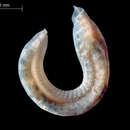Biology
provided by World Register of Marine Species
Females with ripe eggs have been observed in spring and summer. The planktonic larvae occur in waters with a salinity down to 13%. O. limacina is a typical non-selective deposit feeder. The lack of food specialisation of adults contrasts sharply with the selectivity of juveniles for certain types of substrate. The species is food for demersal fish (Hartmann-Schröder, 1971; Wolff, 1973; Curtis, 1977; Kirkegaard, 1978; Fauchald & Jumars, 1979).
Holtmann, S.E.; Groenewold, A.; Schrader, K.H.M.; Asjes, J.; Craeymeersch, J.A.; Duineveld, G.C.A.; van Bostelen, A.J.; van der Meer, J. (1996). Atlas of the zoobenthos of the Dutch continental shelf. Ministry of Transport, Public Works and Water Management: Rijswijk, The Netherlands. ISBN 90-369-4301-9. 243 pp.
- license
- cc-by-4.0
- copyright
- WoRMS Editorial Board
Description
provided by World Register of Marine Species
Bristle worm with a short, thick fusiform body up to 55 mm long. The anterior end is cylindrical; the posterior end is characterised by a ventral groove. The head is a simple smooth cone without appendages, but does have groups of little bristles. The parapodia are in general reduced and bear finger-like gills on the hind part of the body.
Degraer, S.; Wittoeck, J.; Appeltans, W.; Cooreman, K.; Deprez, T.; Hillewaert, H.; Hostens, K.; Mees, J.; Vanden Berghe, E.; Vincx, M. (2006). The macrobenthos atlas of the Belgian part of the North Sea. Belgian Science Policy. D/2005/1191/3. ISBN 90-810081-6-1. 164 pp.
- license
- cc-by-4.0
- copyright
- WoRMS Editorial Board
Distribution
provided by World Register of Marine Species
Saguenay Fjord, northern Gaspe waters, southern Gaspe waters (Baie des Chaleurs, Gaspe Bay to American, Orphan and Bradelle banks; eastern boundary: Eastern Bradelle Valley), downstream part of middle St. Lawrence estuary, lower St. Lawrence estuary, Prince Edward Island (from the northern tip of Miscou Island, N.B. to Cape Breton Island south of Cheticamp, including the Northumberland Strait and Georges Bay to the Canso Strait causeway); Lower North Shore
North-West Atlantic Ocean species (NWARMS)
- license
- cc-by-4.0
- copyright
- WoRMS Editorial Board
Distribution
provided by World Register of Marine Species
O. limacina is found in the Southern Bight, its distribution extending into the marine and central part of the Westerschelde. The polychaete also occurs north of the Wadden islands, at the Cleaver Bank and more offshore at the Dogger Bank, but is absent from the Oyster Ground.
Holtmann, S.E.; Groenewold, A.; Schrader, K.H.M.; Asjes, J.; Craeymeersch, J.A.; Duineveld, G.C.A.; van Bostelen, A.J.; van der Meer, J. (1996). Atlas of the zoobenthos of the Dutch continental shelf. Ministry of Transport, Public Works and Water Management: Rijswijk, The Netherlands. ISBN 90-369-4301-9. 243 pp.
- license
- cc-by-4.0
- copyright
- WoRMS Editorial Board
Distribution
provided by World Register of Marine Species
Ophelia limacina is found on almost the entire Belgian part of the North Sea with a high frequency of occurrence. The distribution of the species is only (very) limited in the coastal zone (1976-1986 period) or in the eastern coastal zone (1994-2001 period). The maximum density of O. limacina is > 600 ind./m2 in the 1976-1986 period whereas this amount fell to a maximum of about 150 ind./m2 in the 1994-2001 period.
Degraer, S.; Wittoeck, J.; Appeltans, W.; Cooreman, K.; Deprez, T.; Hillewaert, H.; Hostens, K.; Mees, J.; Vanden Berghe, E.; Vincx, M. (2006). The macrobenthos atlas of the Belgian part of the North Sea. Belgian Science Policy. D/2005/1191/3. ISBN 90-810081-6-1. 164 pp.
- license
- cc-by-4.0
- copyright
- WoRMS Editorial Board
Habitat
provided by World Register of Marine Species
bathyal, infralittoral and circalittoral of the Gulf and estuary
North-West Atlantic Ocean species (NWARMS)
- license
- cc-by-4.0
- copyright
- WoRMS Editorial Board
Habitat
provided by World Register of Marine Species
The species prefers medium to coarse sands mixed with gravel or shell fragments. Muddy sediments seem to be avoided.
Holtmann, S.E.; Groenewold, A.; Schrader, K.H.M.; Asjes, J.; Craeymeersch, J.A.; Duineveld, G.C.A.; van Bostelen, A.J.; van der Meer, J. (1996). Atlas of the zoobenthos of the Dutch continental shelf. Ministry of Transport, Public Works and Water Management: Rijswijk, The Netherlands. ISBN 90-369-4301-9. 243 pp.
- license
- cc-by-4.0
- copyright
- WoRMS Editorial Board
Habitat
provided by World Register of Marine Species
Ophelia limacina has a clear preference for coarse sediments: a high relative occurrence (> 40%) is reached in sediments with a median grain size of 300 to 550 µm. However, the species is absent in very coarse sediments (> 600 µm). Ophelia limacina tends to prefer sediments with low mud contents (optimum: 0 to 10%). The species does not occur in sediments with a mud content exceeding 20%.
Degraer, S.; Wittoeck, J.; Appeltans, W.; Cooreman, K.; Deprez, T.; Hillewaert, H.; Hostens, K.; Mees, J.; Vanden Berghe, E.; Vincx, M. (2006). The macrobenthos atlas of the Belgian part of the North Sea. Belgian Science Policy. D/2005/1191/3. ISBN 90-810081-6-1. 164 pp.
- license
- cc-by-4.0
- copyright
- WoRMS Editorial Board
Morphology
provided by World Register of Marine Species
Body short, thick and spindle-shaped. Body maximally 50 mm in length and divided into 40 segments. The front part is cylindrical, while the hind part of the body has a ventral groove. The head is pointed, without appendages. Parapodia are inconspicuous and bear finger-like gills on the posterior part of the body. O. limacina is pink to flesh-coloured (Hartmann-Schröder, 1971).
Holtmann, S.E.; Groenewold, A.; Schrader, K.H.M.; Asjes, J.; Craeymeersch, J.A.; Duineveld, G.C.A.; van Bostelen, A.J.; van der Meer, J. (1996). Atlas of the zoobenthos of the Dutch continental shelf. Ministry of Transport, Public Works and Water Management: Rijswijk, The Netherlands. ISBN 90-369-4301-9. 243 pp.
- license
- cc-by-4.0
- copyright
- WoRMS Editorial Board

